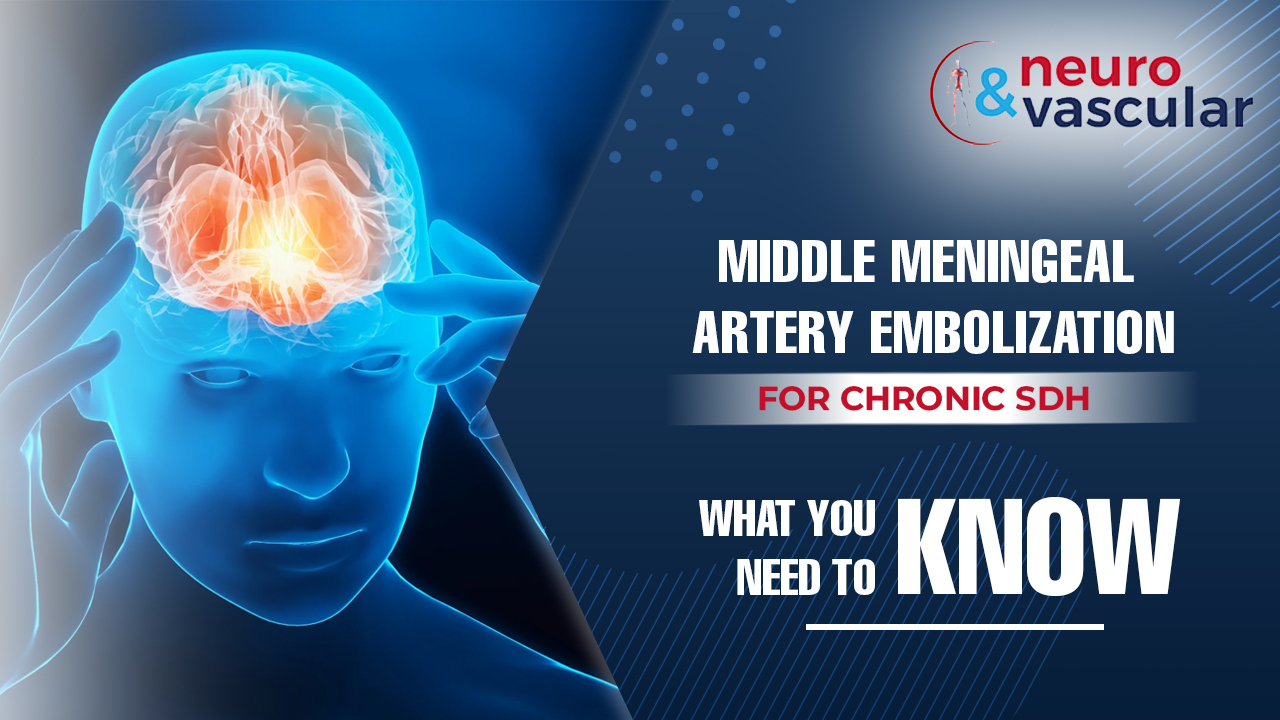
Middle Meningeal Artery Embolization for Chronic SDH: What You Need to Know

What is chronic subdural hematomas or SDH?
Chronic subdural hematomas (SDH) are blood clots that form on the brain’s surface under its protective covering. Typically affecting people over 60, this condition is a result of aging or disease. The accumulation of blood between the brain and the skull makes pressure on the brain, leading to symptoms like headaches, weakness, confusion, and seizures.
While surgery is a common treatment for SDH, it might not be suitable for everyone due to potential risks. That’s where middle meningeal embolization comes in as an alternative solution.
Symptoms of chronic SDH
- Headaches are the most common symptom of chronic subdural hematomas. About 80 percent of patients experience this symptom. However, many other symptoms are also shown in chronic SDH. Such as memory impairment, weakness, nausea, vomiting, impaired vision, confusion, and seizures.
- As the hematoma grows, patients may experience varying degrees of paralysis and potentially go into a coma.
- This chronic subdural hematoma can also be mistaken for other brain diseases and disorders. Such as dementia, stroke, temporary interruption of blood supply to a portion of the brain, or brain lesions like tumors or abscesses.
How does Middle Meningeal Artery Embolization Work for Chronic Subdural Hematomas?
Middle meningeal embolization reduces the blood flow in the dura, which is the brain’s protective cover. This procedure stops the inflammatory process that leads to the growth of subdural fluid.
The procedure is performed under sedation. Generally, it takes less than an hour to complete the treatment process. The interventional radiologist uses advanced imaging technology to determine the required area treatment. A catheter is precisely placed into the femoral or radial artery. From there, the middle meningeal artery in the head is targeted, and the embolic material is injected, effectively blocking blood flow to the brain’s protective covering. Through this treatment process, the abnormal blood fow is halted. In some cases, the subdural hematoma can even regress.
What are the Advantages of Middle Meningeal Embolization for Chronic Subdural Hematomas?
Experience a Minimally Invasive Procedure:
An incision or cutting and opening the skull is not required to complete this procedure. This procedure involves only a small hole in the groin, reducing complications and speeding up recovery.
Achieve Effective Results:
Patients have reported significant reductions in the size of chronic subdural hematomas and relief from brain pressure after middle meningeal embolization.
Enhance Safety:
Compared to surgical removal of the hematoma, this procedure carries a lower risk of complications, making it a safer option for certain individuals including patients who are on blood thinners and patients who are high risk for surgery.
Save Time on Recovery:
Compared to traditional surgery, the recovery time for middle meningeal embolization is significantly shorter, allowing patients to resume their daily activities more quickly.
What You Need to Know about the Subdural Hematoma Embolization Process?
Below are the stages of middle meningeal embolization treatment that can help to treat subdural hematomas.
Step 1: Mapping the Blood Vessels
First, under sedation, a small incision is made, and a catheter is inserted through the femoral/radial artery. This catheter is carefully guided to the middle meningeal artery and a cerebral angiogram is performed to map the blood vessels of the dura contributing to the hematoma.
Step 2 : Embolization process
Through the same catheter used for angiogram, embolic material ( Material used to block the blood vessel) is injected superselectively into the blood vessel supplying the dura. This effectively blocks blood flow to the hematoma, while preserving normal blood supply to the surrounding structures.
Stage 3: Recovery and Follow-Up
After the procedure, patients are closely observed overnight to ensure a smooth recovery. In most cases, patients can go home the following day and resume normal activities within a few days. Our dedicated team of interventional radiologists will provide follow-up care and address any necessary testing.
Crucial Factors to Consider for Middle Meningeal Embolization for Chronic Subdural Hematomas:
We always give priority to patient well-being and safety. That’s why we recognize the uniqueness of each individual. When evaluating a patient’s suitability for middle meningeal embolization for chronic subdural hematomas, it is essential to carefully consider several key factors. These factors involve assessing the hematoma’s size and location. Also, evaluate the patient’s overall health and any underlying medical conditions that may influence their ability to undergo the procedure.
Conclusion:
Treating chronic SDH through middle meningeal artery embolization is an effective and promising treatment. It helps to reduce pain and provide long-term relief. This chronic SDH procedure offers a less-invasive option than open brain surgery, with fewer risks. In addition, this modality can be done under sedation/local anesthesia. So patients can return to normal activities soon after the intervention. If you are currently experiencing any signs or symptoms of chronic SDH, it is important to seek medical attention right away for proper diagnosis and management. Visit your Interventional Radiologist for more details about the procedure. There you can get expert care in each step of the way.
About the Author:

Name: DR . SURESH GIRAGANI
INTERVENTIONAL RADIOLOGIST
DR. SURESH GIRAGANI CONSULTANT INTERVENTIONAL RADIOLOGIST at Apollo hospitals Jubilee Hills has more than sixteen years of clinical experience in vascular interventions with a special interest in neurovascular and peripheral vascular disease interventional procedures.